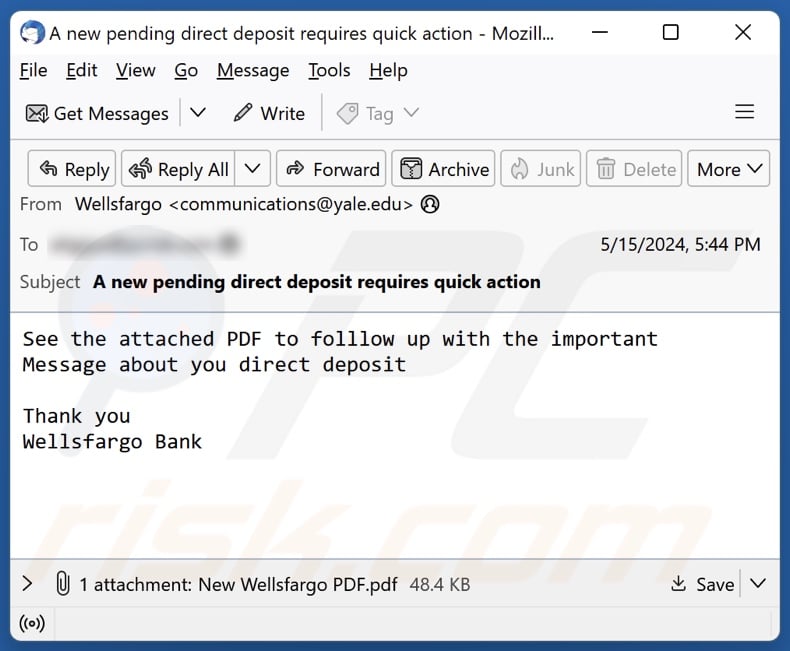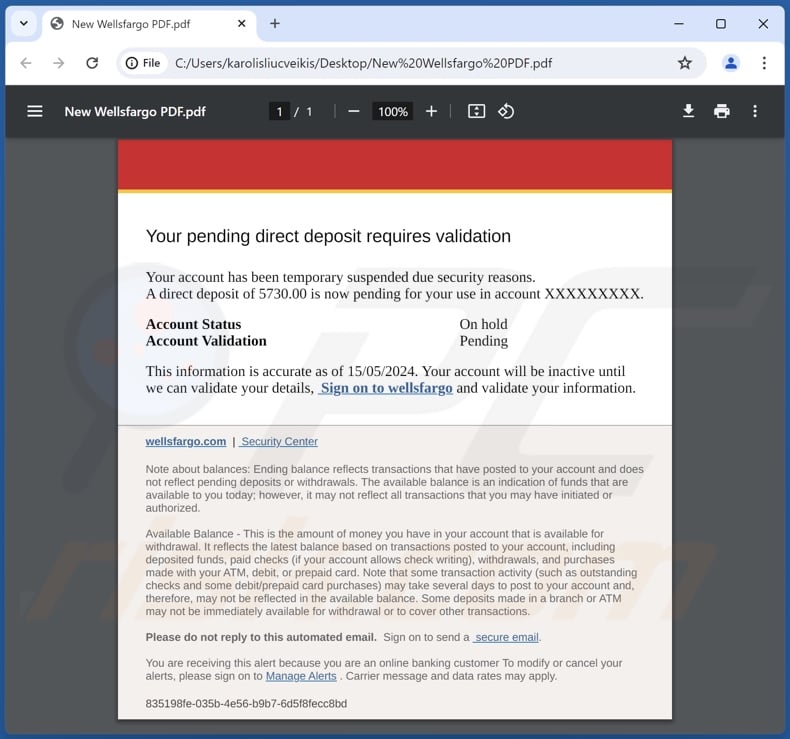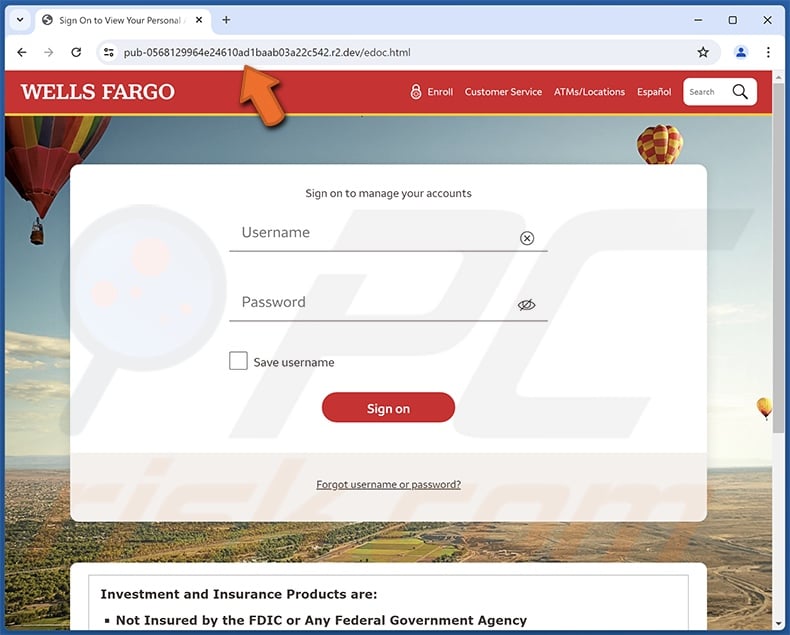Avoid losing your account via fake "Wells Fargo - Direct Deposit" emails
Phishing/ScamAlso Known As: "Wells Fargo - Direct Deposit" phishing email
Get free scan and check if your device is infected.
Remove it nowTo use full-featured product, you have to purchase a license for Combo Cleaner. Seven days free trial available. Combo Cleaner is owned and operated by RCS LT, the parent company of PCRisk.com.
What kind of email is "Wells Fargo - Direct Deposit"?
After inspecting this "Wells Fargo - Direct Deposit" email, we determined that it is fake. This spam letter imitates a notification from Wells Fargo & Company – a multinational financial services company. The goal of this fraudulent mail is to deceive recipients into providing their account credentials to a phishing website.
It must be emphasized that this scam email is in no way associated with the real Wells Fargo or any other legitimate entities.

"Wells Fargo - Direct Deposit" email scam overview
The spam email with the subject "A new pending direct deposit requires quick action" (may vary) is presented as a message from Wells Fargo. It is brief and simply instructs the recipient to review the attached PDF document.
The attachment resumes with the charade; essentially, the lure relates to a supposed temporary suspension of the recipient's Wells Fargo account. Additionally, the document states that a direct deposit of 5730.00 (currency unspecified) is pending. The suspension is explained as a security measure due to inaccurate account information. The user is instructed to validate their account, thus releasing the pending deposit.
It must be reiterated that all this information is false, and this mail is not associated with the actual Wells Fargo & Company or any other entities.
This attachment endorses a phishing website impersonating the Wells Fargo sign-in page. Log-in credentials entered into this site are recorded and sent to cyber criminals. Hence, they might gain access and control over the compromised account.
Stealing finance-related platforms can enable criminals to make fraudulent transactions, online purchases, or perform other nefarious activities.
In summary, victims of scam mail like "Wells Fargo - Direct Deposit" can experience severe privacy issues, financial losses, and even identity theft.
If you have already provided your log-in credentials to a phishing site – immediately change the passwords of all possibly exposed accounts and inform their official support. Depending on the sensitivity of the compromised information, it might also be necessary to contact the appropriate authorities.
| Name | "Wells Fargo - Direct Deposit" phishing email |
| Threat Type | Phishing, Scam, Social Engineering, Fraud |
| Fake Claim | Recipient's Wells Fargo account was suspended and a direct deposit is pending. |
| Disguise | Wells Fargo |
| Attachment(s) | New Wellsfargo PDF.pdf (filename may vary) |
| Symptoms | Unauthorized online purchases, changed online account passwords, identity theft, illegal access of the computer. |
| Distribution methods | Deceptive emails, rogue online pop-up ads, search engine poisoning techniques, misspelled domains. |
| Damage | Loss of sensitive private information, monetary loss, identity theft. |
| Malware Removal (Windows) |
To eliminate possible malware infections, scan your computer with legitimate antivirus software. Our security researchers recommend using Combo Cleaner. Download Combo CleanerTo use full-featured product, you have to purchase a license for Combo Cleaner. 7 days free trial available. Combo Cleaner is owned and operated by RCS LT, the parent company of PCRisk.com. |
Phishing spam campaign examples
"Pass-code Expires Today", "Roundcube Found Several Undelivered Messages", "Specification Of Products", "New Messages Notification", and "DNS Error" are merely some examples of phishing emails we have written about recently.
These letters primarily target the log-in credentials of various accounts (e.g., online banking, money transferring, e-commerce, cryptowallets, emails, social media, etc.), personally identifiable information, and finance-related data.
However, other scams are promoted through spam mail as well. Additionally, it is used to proliferate malware (e.g., trojans, ransomware, cryptominers, etc.).
Spam emails can be plain and full of grammatical/spelling errors or be competently crafted and believably disguised as messages from genuine entities (e.g., companies, service providers, institutions, authorities, etc.).
How do spam campaigns infect computers?
Cyber criminals commonly use spam campaigns to proliferate malware. These emails/messages can include malicious files as attachments or download links. The files can be documents (PDF, Microsoft Office, Microsoft OneNote, etc.), executables (.exe, .run, etc.), archives (ZIP, RAR, etc.), JavaScript, and so on.
Once an infectious file is executed, run, or otherwise opened – the malware downloads/installation is triggered. Some formats need extra interaction to infect systems. For example, Microsoft Office files require users to enable macro commands (i.e., editing/content), while OneNote documents need them to click on embedded links or files.
How to avoid installation of malware?
Incoming emails, DMs/PMs, SMSes, and other messages must be approached with caution. Attachments or links present in suspect/irrelevant mail must not be opened, as they can be virulent.
It must be mentioned that malware is not distributed only through spam mail. Therefore, we recommend being careful while browsing since fake and malicious online content usually appears legitimate and innocuous.
Additionally, all downloads must be made from official and trustworthy channels. Another recommendation is to activate and update programs using genuine functions/tools, as illegal activation tools ("cracks") and third-party updaters may contain malware.
We must emphasize the importance of having a reputable anti-virus installed and kept up-to-date. Security software must be used to perform regular system scans and to remove detected threats. If you've already opened malicious attachments, we recommend running a scan with Combo Cleaner Antivirus for Windows to automatically eliminate infiltrated malware.
Text presented in the "Wells Fargo - Direct Deposit" spam email letter:
Subject: A new pending direct deposit requires quick action
See the attached PDF to folllow up with the important
Message about you direct deposit
Thank you
Wellsfargo Bank
Screenshot of "Wells Fargo - Direct Deposit" spam email's attachment ("New Wellsfargo PDF.pdf"):

Text presented in the attached file:
Your pending direct deposit requires validation
Your account has been temporary suspended due security reasons.
A direct deposit of 5730.00 is now pending for your use in account XXXXXXXXX.
Account Status On hold
Account Validation Pending
This information is accurate as of 15/05/2024. Your account will be inactive until
we can validate your details, Sign on to wellsfargo and validate your information.
wellsfargo.com | Security Center
Note about balances: Ending balance reflects transactions that have posted to your account and does
not reflect pending deposits or withdrawals. The available balance is an indication of funds that are
available to you today; however, it may not reflect all transactions that you may have initiated or
authorized.
Available Balance - This is the amount of money you have in your account that is available for
withdrawal. It reflects the latest balance based on transactions posted to your account, including
deposited funds, paid checks (if your account allows check writing), withdrawals, and purchases
made with your ATM, debit, or prepaid card. Note that some transaction activity (such as outstanding
checks and some debit/prepaid card purchases) may take several days to post to your account and,
therefore, may not be reflected in the available balance. Some deposits made in a branch or ATM
may not be immediately available for withdrawal or to cover other transactions.
Please do not reply to this automated email. Sign on to send a secure email.
You are receiving this alert because you are an online banking customer To modify or cancel your
alerts, please sign on to Manage Alerts . Carrier message and data rates may apply.
835198fe-035b-4e56-b9b7-6d5f8fecc8bd
Screenshot of the phishing website promoted by the "Wells Fargo - Direct Deposit" spam campaign:

Instant automatic malware removal:
Manual threat removal might be a lengthy and complicated process that requires advanced IT skills. Combo Cleaner is a professional automatic malware removal tool that is recommended to get rid of malware. Download it by clicking the button below:
DOWNLOAD Combo CleanerBy downloading any software listed on this website you agree to our Privacy Policy and Terms of Use. To use full-featured product, you have to purchase a license for Combo Cleaner. 7 days free trial available. Combo Cleaner is owned and operated by RCS LT, the parent company of PCRisk.com.
Quick menu:
- What is "Wells Fargo - Direct Deposit" phishing email?
- Types of malicious emails.
- How to spot a malicious email?
- What to do if you fell for an email scam?
Types of malicious emails:
![]() Phishing Emails
Phishing Emails
Most commonly, cybercriminals use deceptive emails to trick Internet users into giving away their sensitive private information, for example, login information for various online services, email accounts, or online banking information.
Such attacks are called phishing. In a phishing attack, cybercriminals usually send an email message with some popular service logo (for example, Microsoft, DHL, Amazon, Netflix), create urgency (wrong shipping address, expired password, etc.), and place a link which they hope their potential victims will click on.
After clicking the link presented in such email message, victims are redirected to a fake website that looks identical or extremely similar to the original one. Victims are then asked to enter their password, credit card details, or some other information that gets stolen by cybercriminals.
![]() Emails with Malicious Attachments
Emails with Malicious Attachments
Another popular attack vector is email spam with malicious attachments that infect users' computers with malware. Malicious attachments usually carry trojans that are capable of stealing passwords, banking information, and other sensitive information.
In such attacks, cybercriminals' main goal is to trick their potential victims into opening an infected email attachment. To achieve this goal, email messages usually talk about recently received invoices, faxes, or voice messages.
If a potential victim falls for the lure and opens the attachment, their computers get infected, and cybercriminals can collect a lot of sensitive information.
While it's a more complicated method to steal personal information (spam filters and antivirus programs usually detect such attempts), if successful, cybercriminals can get a much wider array of data and can collect information for a long period of time.
![]() Sextortion Emails
Sextortion Emails
This is a type of phishing. In this case, users receive an email claiming that a cybercriminal could access the webcam of the potential victim and has a video recording of one's masturbation.
To get rid of the video, victims are asked to pay a ransom (usually using Bitcoin or another cryptocurrency). Nevertheless, all of these claims are false - users who receive such emails should ignore and delete them.
How to spot a malicious email?
While cyber criminals try to make their lure emails look trustworthy, here are some things that you should look for when trying to spot a phishing email:
- Check the sender's ("from") email address: Hover your mouse over the "from" address and check if it's legitimate. For example, if you received an email from Microsoft, be sure to check if the email address is @microsoft.com and not something suspicious like @m1crosoft.com, @microsfot.com, @account-security-noreply.com, etc.
- Check for generic greetings: If the greeting in the email is "Dear user", "Dear @youremail.com", "Dear valued customer", this should raise suspiciousness. Most commonly, companies call you by your name. Lack of this information could signal a phishing attempt.
- Check the links in the email: Hover your mouse over the link presented in the email, if the link that appears seems suspicious, don't click it. For example, if you received an email from Microsoft and the link in the email shows that it will go to firebasestorage.googleapis.com/v0... you shouldn't trust it. It's best not to click any links in the emails but to visit the company website that sent you the email in the first place.
- Don't blindly trust email attachments: Most commonly, legitimate companies will ask you to log in to their website and to view any documents there; if you received an email with an attachment, it's a good idea to scan it with an antivirus application. Infected email attachments are a common attack vector used by cybercriminals.
To minimise the risk of opening phishing and malicious emails we recommend using Combo Cleaner Antivirus for Windows.
Example of a spam email:

What to do if you fell for an email scam?
- If you clicked on a link in a phishing email and entered your password - be sure to change your password as soon as possible. Usually, cybercriminals collect stolen credentials and then sell them to other groups that use them for malicious purposes. If you change your password in a timely manner, there's a chance that criminals won't have enough time to do any damage.
- If you entered your credit card information - contact your bank as soon as possible and explain the situation. There's a good chance that you will need to cancel your compromised credit card and get a new one.
- If you see any signs of identity theft - you should immediately contact the Federal Trade Commission. This institution will collect information about your situation and create a personal recovery plan.
- If you opened a malicious attachment - your computer is probably infected, you should scan it with a reputable antivirus application. For this purpose, we recommend using Combo Cleaner Antivirus for Windows.
- Help other Internet users - report phishing emails to Anti-Phishing Working Group, FBI’s Internet Crime Complaint Center, National Fraud Information Center and U.S. Department of Justice.
Frequently Asked Questions (FAQ)
Why did I receive this email?
Regardless of any relevant details that they may include, spam emails are not personal. These messages are distributed in large-scale operations – hence, thousands of users receive identical emails.
I have provided my personal information when tricked by this spam email, what should I do?
If you have disclosed your log-in credentials – change the password of all possibly exposed accounts and inform their official support without delay. And if you've provided other private data (e.g., passport photos/scans, credit card numbers, ID card details, etc.) – immediately contact the corresponding authorities.
I have read a spam email but didn't open the attachment, is my computer infected?
No, merely reading an email will not trigger any malware download/installation processes. Systems are infected when malicious attachments or links are opened/clicked.
I have downloaded and opened a file attached to a spam email, is my computer infected?
Whether your device was infected depends on the purpose of the attached file (i.e., phishing or malware download/installation). It might also be impacted by the format of the opened file. Executables (.exe, .run, etc.) cause infections almost without fail. While other formats like documents (.doc, .xls, .pdf, .one, etc.) may need additional actions to begin infection processes (e.g., enabling macros, clicking embedded content, etc.).
Will Combo Cleaner remove malware infections present in email attachments?
Yes, Combo Cleaner can detect and eliminate most of the known malware infections. Keep in mind that performing a full system scan is crucial since high-end malicious programs usually hide deep within systems.
Share:

Tomas Meskauskas
Expert security researcher, professional malware analyst
I am passionate about computer security and technology. I have an experience of over 10 years working in various companies related to computer technical issue solving and Internet security. I have been working as an author and editor for pcrisk.com since 2010. Follow me on Twitter and LinkedIn to stay informed about the latest online security threats.
PCrisk security portal is brought by a company RCS LT.
Joined forces of security researchers help educate computer users about the latest online security threats. More information about the company RCS LT.
Our malware removal guides are free. However, if you want to support us you can send us a donation.
DonatePCrisk security portal is brought by a company RCS LT.
Joined forces of security researchers help educate computer users about the latest online security threats. More information about the company RCS LT.
Our malware removal guides are free. However, if you want to support us you can send us a donation.
Donate
▼ Show Discussion